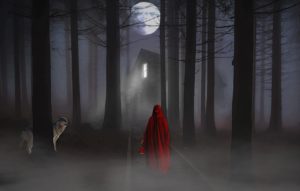The True Story Behind Little Red Riding Hood
Instructions
What Really Happened to Little Red?
Option #2: What Really Happened to Little Red?
Revisit the original childhood tale of “Little Red Riding Hood” athttp://www.pitt.edu/~dash/type0333.html#grimm. Identify the thesis and the primary supporting details. Keeping the main idea of the story, rewrite the ending, beginning with this sentence:
“Meanwhile the wolf ran straight to the grandmother’s house and knocked at the door.”
Consider creating an introduction that summarizes the beginning of the story and ends with the thesis statement. A thesis statement for this essay should be an overview of the fable’s moral and a brief preview of the main events in the remainder of the story that you are rewriting.
Thesis example: “Before Little Red Riding Hood leaves her house, her mother reminds her of the dangers of talking to strangers, but Red doesn’t realize that evil can sometimes disguise itself and hurt family members.”
After you create the thesis, begin rewriting the fable’s new ending in the first body paragraph beginning with the suggested sentence: “Meanwhile the wolf ran straight to the grandmother’s house and knocked at the door.” Remember to sum up the story as well as the moral in the conclusion.
Introduction
The little red riding hood is a tale written by the Grimm brothers. The fable contains moral lessons that make the book quite interesting to read. It was meant for children considering the fact that they were key moral lessons to be learned from the whole ordeal. Critics explain that the contents of the books contain ethical factors that are important for the children to learn. The story has remained relevant for many years considering the fact that they reflect on the basic issues that surround a child’s daily life. Little red riding hood realizes the dangers of talking to strangers after the wolf attacked her grandmother.
Body
The little girl had decided to visit her lovely grandmother because they had taken a long while before talking. The mother is quite cautious about the dangers that exist in the forests and warn her about talking to strangers. The girl does not consider the dangers that she had been warned about. She starts picking up flowers while joyfully walking down the forest. She talks to a cunning wolf that was eager to eat her grandmother and herself without knowing. This is a key issue that later haunts her as she continues with the journey to her grandmother.
The wolf takes up a shortcut to the grandmother’s place. It readily disguises itself as the little girl and gallops up the grandmother unknowingly. Later on, the little girl arrives and finds out that the grandmother had changed in appearance. As time proceeds, she realizes that the grandmother was not there. Instead, the wolf was ready to eat her up. She started screaming while running around the house. A woodman in the nearby forest heard her cries and came to her rescue. He rescued the girl together with the grandmother and the two had a nice evening together.
Conclusion
The key moral lesson to children reflected in the fable is the dangers that exist when a child decides to talk to strangers. The story acts as a warning to the children that have the behavior of talking to people that they do not know. This plays a vital part in the creation of moral standards in a child. The wolf acts as the existing dangers that come with disobedience. The story is popular because of the entertainment that it brings out to the readers together with the moral lessons that it has to the children.






